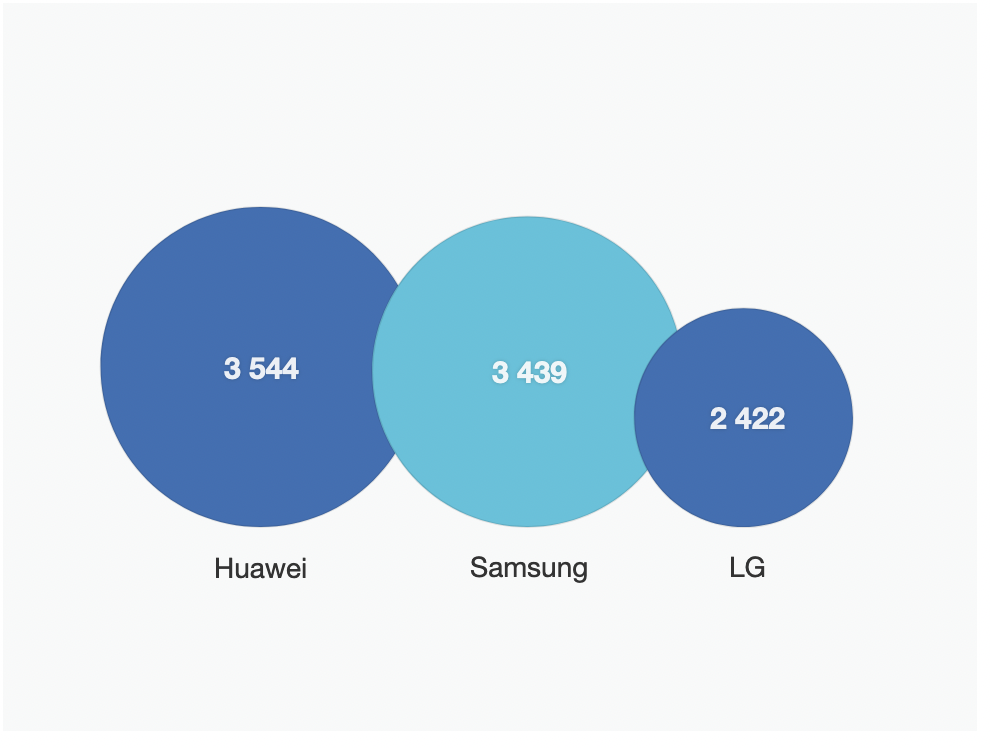“Huawei of China was the largest European patent applicant in 2021, with 3,544 applications, followed by Samsung and LG.”

Top 2021 EPO filers – Source: EPO Patent Index 2021
There were 188,600 European patent applications filed last year, an annual increase of 4.5%, according to figures published by the European Patent Office (EPO) on April 5.
Despite the impact of the pandemic, applications increased to a record level following a slight decline in 2020.
The United States was once again the top country for applicants, accounting for a total of 46,533 applications in 2021 (an increase of 5.2%) or 25% of all filings. It was followed by Germany and Japan, with China ranking fourth.
Applications from China increased by 24% to 16,665 in 2021; they have quadrupled in the past decade. Other notable increases were from Sweden (up 12% to 4,954), Canada (up 18.4% to 2,083) and India (up 16.5% to 817).
Ranked by the number of applications compared to population, Switzerland was the top country, followed by Sweden, Denmark, the Netherlands and Finland.
The number of patents granted in 2021 fell by 18.6% to 108,799. This followed a surge in the number of grants in 2015-2019, due to the reduction in pendency for examinations.
Technology Fields
The most popular technology field overall was digital communications (15,400 applications, up 9.4%) followed by medical technology (15,321, up 0.8%) and computer technology (14,671, up 9.7%).
Among U.S. applicants, the most popular field was medical technology (5,865 applications) followed by computer technology (5,294), digital communication (3,743), pharmaceuticals (3,582) and biotechnology (2,611).
Applications in most technology fields increased in 2021. The biggest increases were in micro-structural and nanotechnology (up 27% from 115 to 146), audio-visual technology (up 24%) and semiconductors (up 21%).
Areas where applications declined included basic communication processes (down 7.3%), analysis of biological materials (down 6%), basic materials chemistry (down 4.9%) and textile and paper machines (down 4.6%).
Biggest Applicants
Huawei of China was the largest applicant in 2021, with 3,544 applications, followed by Samsung and LG. The highest-placed U.S. company was Raytheon Technologies in sixth place (1,623 applications) followed by Qualcomm in seventh (1,534).
The data was published by the EPO in the Patent Index 2021. European patent applications include direct European applications and international (PCT) applications that entered the European phase during the year.
Quality Indicators
The EPO has also published data on some of its quality metrics. Search timeliness increased from 4.3 months in 2020 to 4.8 months in 2021, while examination timeliness fell from 23.7 months to 23.0 months. The average duration of opposition proceedings increased from 15.4 months to 19.3 months.
The Patent Index includes graphs, charts, videos, case studies and a podcast as well as articles on vaccine technologies and smart urban mobility. Statistics for the past 10 years and country profiles can also be downloaded and are available on the Data Hub mobile app.

![[IPWatchdog Logo]](https://ipwatchdog.com/wp-content/themes/IPWatchdog%20-%202023/assets/images/temp/logo-small@2x.png)

![[Advertisement]](https://ipwatchdog.com/wp-content/uploads/2024/04/Patent-Litigation-Masters-2024-sidebar-early-bird-ends-Apr-21-last-chance-700x500-1.jpg)

![[Advertisement]](https://ipwatchdog.com/wp-content/uploads/2021/12/WEBINAR-336-x-280-px.png)
![[Advertisement]](https://ipwatchdog.com/wp-content/uploads/2021/12/2021-Patent-Practice-on-Demand-recorded-Feb-2021-336-x-280.jpg)
![[Advertisement]](https://ipwatchdog.com/wp-content/uploads/2021/12/Ad-4-The-Invent-Patent-System™.png)







Join the Discussion
One comment so far.
Anon
April 7, 2022 09:44 amI do wonder how the numbers would come out if they were organized differently — for example, computing arts and software (per se or otherwise) are KNOWN to largely span most all traditional art units (outside of the chem and bio-chem).
Even (or perhaps more aptly, especially) in view of the EP’s “stated” prohibition against software per se and as such, how much innovation — and how much of all innovation — that is being shared in the hopes of innovation protection belongs to the computing arts?